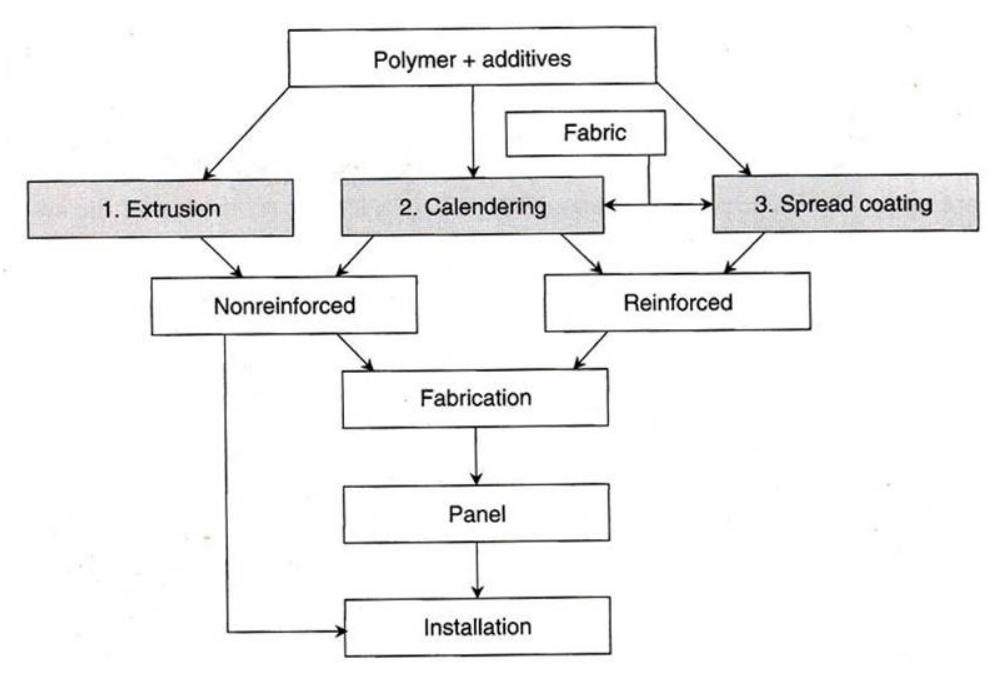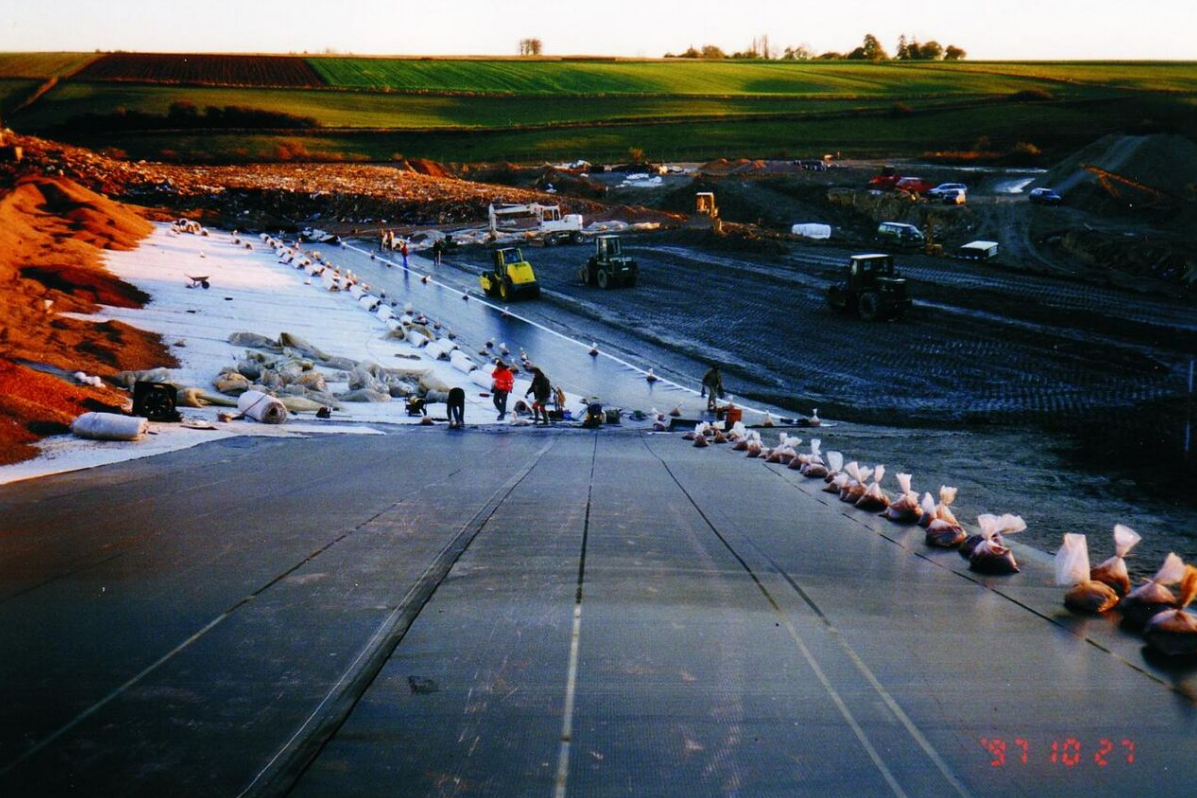
| Version | Summary | Created by | Modification | Content Size | Created at | Operation |
|---|---|---|---|---|---|---|
| 1 | Beatrix Zheng | -- | 1315 | 2022-10-20 01:31:06 |
Video Upload Options
A geomembrane is very low permeability synthetic membrane liner or barrier used with any geotechnical engineering related material so as to control fluid (or gas) migration in a human-made project, structure, or system. Geomembranes are made from relatively thin continuous polymeric sheets, but they can also be made from the impregnation of geotextiles with asphalt, elastomer or polymer sprays, or as multilayered bitumen geocomposites. Continuous polymer sheet geomembranes are, by far, the most common.
1. Manufacturing
The manufacturing of geomembranes begins with the production of the raw materials, which include the polymer resin, and various additives such as antioxidants, plasticizers, fillers, carbon black, and lubricants (as a processing aid). These raw materials (i.e., the "formulation") are then processed into sheets of various widths and thickness by extrusion, calendering, and/or spread coating.

- high-density polyethylene (HDPE) ~ 35% or 105 M m2
- linear low-density polyethylene (LLDPE) ~ 25% or 75 M m2
- polyvinyl chloride (PVC) ~ 25% or 75 M m2
- flexible polypropylene (fPP) ~ 10% or 30 M m2
- chlorosulfonated polyethylene (CSPE) ~ 2% or 6 M m2
- ethylene propylene diene terpolymer (EPDM) ~ 3% or 9 M m2
The above represents approximately $1.8 billion in worldwide sales. Projections for future geomembrane usage are strongly dependent on the application and geographical location. Landfill liners and covers in North America and Europe will probably see modest growth (~ 5%), while in other parts of the world growth could be dramatic (10–15%). Perhaps the greatest increases will be seen in the containment of coal ash and heap leach mining for precious metal capture.
2. Properties
The majority of generic geomembrane test methods that are referenced worldwide are by the ASTM International|American Society of Testing and Materials (ASTM) due to their long history in this activity. More recent are test method developed by the International Organization for Standardization (ISO). Lastly, the Geosynthetic Research Institute (GRI) has developed test methods that are only for test methods not addressed by ASTM or ISO. Of course, individual countries and manufacturers often have specific (and sometimes) proprietary test methods.
2.1. Physical Properties
The main physical properties of geomembranes in the as-manufactured state are:
- Thickness (smooth sheet, textured, asperity height)
- Density
- Melt flow index
- Mass per unit area (weight)
- Vapor transmission (water and solvent).
2.2. Mechanical Properties
There are a number of mechanical tests that have been developed to determine the strength of polymeric sheet materials. Many have been adopted for use in evaluating geomembranes. They represent both quality control and design, i.e., index versus performance tests.
- tensile strength and elongation (index, wide width, axisymmetric, and seams)
- tear resistance
- impact resistance
- puncture resistance
- interface shear strength
- anchorage strength
- stress cracking (constant load and single point).
2.3. Endurance
Any phenomenon that causes polymeric chain scission, bond breaking, additive depletion, or extraction within the geomembrane must be considered as compromising to its long-term performance. There are a number of potential concerns in this regard. While each is material-specific, the general behavior trend is to cause the geomembrane to become brittle in its stress-strain behavior over time. There are several mechanical properties to track in monitoring such long term degradation: the decrease in elongation at failure, the increase in modulus of elasticity, the increase (then decrease) in stress at failure (i.e., strength), and the general loss of ductility. Obviously, many of the physical and mechanical properties could be used to monitor the polymeric degradation process.
- ultraviolet light exposure (laboratory of field)
- radioactive degradation
- biological degradation (animals, fungi or bacteria)
- chemical degradation
- thermal behavior (hot or cold)
- oxidative degradation.
2.4. Lifetime
Geomembranes degrade slowly enough that their lifetime behavior is as yet uncharted. Thus, accelerated testing, either by high stress, elevated temperatures and/or aggressive liquids, is the only way to determine how the material will behave long-term. Lifetime prediction methods use the following means of interpreting the data:
- Stress limit testing: A method by the HDPE pipe industry in the United States for determining the value of hydrostatic design basis stress.
- Rate process method: Used in Europe for pipes and geomembranes, the method yields similar results as stress limit testing.
- Hoechst multiparameter approach: A method that utilizes biaxial stresses and stress relaxation for lifetime prediction and can include seams as well.
- Arrhenius modeling: A method for testing geomembranes (and other geosynthetics) described in Koerner for both buried and exposed conditions.[1]
3. Seaming
The fundamental mechanism of seaming polymeric geomembrane sheets together is to temporarily reorganize the polymer structure (by melting or softening) of the two opposing surfaces to be joined in a controlled manner that, after the application of pressure, results in the two sheets being bonded together. This reorganization results from an input of energy that originates from either thermal or chemical processes. These processes may involve the addition of additional polymer in the area to be bonded.
Ideally, seaming two geomembrane sheets should result in no net loss of tensile strength across the two sheets, and the joined sheets should perform as one single geomembrane sheet. However, due to stress concentrations resulting from the seam geometry, current seaming techniques may result in minor tensile strength and/or elongation loss relative to the parent sheet. The characteristics of the seamed area are a function of the type of geomembrane and the seaming technique used.
4. Applications

Geomembranes have been used in the following environmental, geotechnical, hydraulic, transportation, and private development applications:
- As liners for potable water
- As liners for reserve water (e.g., safe shutdown of nuclear facilities)
- As liners for waste liquids (e.g., sewage sludge)
- Liners for radioactive or hazardous waste liquid
- As liners for secondary containment of underground storage tanks
- As liners for solar ponds
- As liners for brine solutions
- As liners for the agriculture industry
- As liners for the aquiculture industry, such as fish/shrimp pond
- As liners for golf course water holes and sand bunkers
- As liners for all types of decorative and architectural ponds
- As liners for water conveyance canals
- As liners for various waste conveyance canals
- As liners for primary, secondary, and/or tertiary solid-waste landfills and waste piles
- As liners for heap leach pads
- As covers (caps) for solid-waste landfills
- As covers for aerobic and anaerobic manure digesters in the agriculture industry
- As covers for power plant coal ash
- As liners for vertical walls: single or double with leak detection
- As cutoffs within zoned earth dams for seepage control
- As linings for emergency spillways
- As waterproofing liners within tunnels and pipelines
- As waterproof facing of earth and rockfill dams
- As waterproof facing for roller compacted concrete dams
- As waterproof facing for masonry and concrete dams
- Within cofferdams for seepage control
- As floating reservoirs for seepage control
- As floating reservoir covers for preventing pollution
- To contain and transport liquids in trucks
- To contain and transport potable water and other liquids in the ocean
- As a barrier to odors from landfills
- As a barrier to vapors (radon, hydrocarbons, etc.) beneath buildings
- To control expansive soils
- To control frost-susceptible soils
- To shield sinkhole-susceptible areas from flowing water
- To prevent infiltration of water in sensitive areas
- To form barrier tubes as dams
- To face structural supports as temporary cofferdams
- To conduct water flow into preferred paths
- Beneath highways to prevent pollution from deicing salts
- Beneath and adjacent to highways to capture hazardous liquid spills
- As containment structures for temporary surcharges
- To aid in establishing uniformity of subsurface compressibility and subsidence
- Beneath asphalt overlays as a waterproofing layer
- To contain seepage losses in existing above-ground tanks
- As flexible forms where loss of material cannot be allowed.
References
- Koerner, R. M. (2012). Designing With Geosynthetics (6th ed.). Xlibris Publishing Co., 914 pgs..
- Müller, W. W.; Saathoff, F. (2015). "Geosynthetics in geoenvironmental engineering". Science and Technology of Advanced Materials 16 (3): 034605. doi:10.1088/1468-6996/16/3/034605. PMID 27877792. Bibcode: 2015STAdM..16c4605M.
- Müller, W. W.; Saathoff, F. (2015). "Geosynthetics in geoenvironmental engineering". Science and Technology of Advanced Materials 16 (3): 034605. doi:10.1088/1468-6996/16/3/034605. PMID 27877792. Bibcode: 2015STAdM..16c4605M.
- Müller, W. W.; Saathoff, F. (2015). "Geosynthetics in geoenvironmental engineering". Science and Technology of Advanced Materials 16 (3): 034605. doi:10.1088/1468-6996/16/3/034605. PMID 27877792. Bibcode: 2015STAdM..16c4605M.
- Koerner, R. M. (2012). Designing With Geosynthetics (6th ed.). Xlibris Publishing Co., 914 pgs..
- Müller, W. W.; Saathoff, F. (2015). "Geosynthetics in geoenvironmental engineering". Science and Technology of Advanced Materials 16 (3): 034605. doi:10.1088/1468-6996/16/3/034605. PMID 27877792. Bibcode: 2015STAdM..16c4605M.




